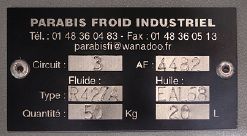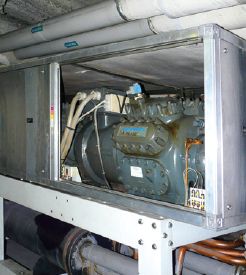This quick and efficient retrofit falls within the scope of Icade Eurogem’s environmental policy.
Icade Eurogem and its Facility Management department are responsible for managing the Antin Opéra building, located at 66 rue d’Antin, Paris. Keen to avoid future environmental risks, the Site Manager, Mr Bakkti, enlisted the help of Parabis Froid Industriel to retrofit the chiller supplying the building’s air conditioning system. The Climaveneta chiller consists of three circuits, each containing a Refcomp 8-cylinder reciprocating compressor with a cooling capacity of 400W. Its total cooling capacity is therefore 1.2MW.
In early 2008, Parabis Froid Industriel, represented by Mr. Aubéri Lecat, informed its customer, Icade Eurogem, about the potential R-22 shortage, and proposed a three-stage retrofit, so as not to inconvenience the building’s occupants and in order to spread the cost of the retrofit over time. Icade Eurogem accepted this proposal. “By acting now we can limit the risks in the event of a leak in the system,” explained Mr Bakkti. The first stage was performed in September 2008, with the retrofit of circuit number 3. Thesecond circuit was retrofitted in June 2009 and the third and final stage is scheduled for early 2010. Let’s take a look at the methodology used for each of these three stages.
A 4-phase retrofit procedure:
![]() Parabis Froid Industriel takes a comprehensive set of readings to determine the system’s performance levels, then performs a periodic oil diagnostic test (DPH A). “I explain to customers that the oil sample is essential, as it will tell us whether or not the system is in good condition. It’s like taking a blood sample before an operation,” says Aubéri Lecat. A thorough search for leaks is also conducted, which makes it possible to anticipate any repairs that may be necessary. At this point, all the data are sent to Climalife, who create a thermodynamic model of the system in order to determine the most appropriate replacement refrigerant. R-427A is selected for its energy performance and its cooling performance.
Parabis Froid Industriel takes a comprehensive set of readings to determine the system’s performance levels, then performs a periodic oil diagnostic test (DPH A). “I explain to customers that the oil sample is essential, as it will tell us whether or not the system is in good condition. It’s like taking a blood sample before an operation,” says Aubéri Lecat. A thorough search for leaks is also conducted, which makes it possible to anticipate any repairs that may be necessary. At this point, all the data are sent to Climalife, who create a thermodynamic model of the system in order to determine the most appropriate replacement refrigerant. R-427A is selected for its energy performance and its cooling performance.
![]() Parabis refrigeration technician Joël Poiret secures the system and recovers the R-22 fluid charge in transfer bottles. The compressor is purged, then opened so that a mechanical service can be performed (replacement of worn parts and identified valves, springs and neoprene rubber gaskets). The four dryer cartridges are replaced and the compressor is refilled with 20 litres of MOBIL EAL Arctic 68 polyol ester oil, then the system is vacuum pumped. In order to recover as much as possible of the residual mineral oil ontained in the circuit, the 52kg charge of R-22 is reintroduced into the system for 24-30 hours of operation. Readings are taken.
Parabis refrigeration technician Joël Poiret secures the system and recovers the R-22 fluid charge in transfer bottles. The compressor is purged, then opened so that a mechanical service can be performed (replacement of worn parts and identified valves, springs and neoprene rubber gaskets). The four dryer cartridges are replaced and the compressor is refilled with 20 litres of MOBIL EAL Arctic 68 polyol ester oil, then the system is vacuum pumped. In order to recover as much as possible of the residual mineral oil ontained in the circuit, the 52kg charge of R-22 is reintroduced into the system for 24-30 hours of operation. Readings are taken.
![]()
The system is again secured and the R-22 is recovered in specific recovery cylinders. The recovered R-22 is weighed before being transferred to Climalife for treatment, along with the duly completed Waste Tracking Form. The compressor’s oil charge is replenished and the dryer cartridges are changed for a second time. After being vacuum pumped, the system is charged to around 95% of its nominal charge (50kg) with the replacement refrigerant, R-427A. The system can now operate again. All that is required is an adjustment of the expansion valve. An extremely thorough search for leaks is performed to ensure optimum containment. A label is affixed to the system, as required by current regulations, and a final set of readings is taken for comparison with the initial measurements, to identify any changes in performance.

![]() After a few days of operation, another oil sample is taken using a Climalife DPH E, in order to determine how much of the original oil remains after the retrofit. According to Aubéri Lecat, “this final stage is crucial to ensure that everything is working properly. It tells us whether we have to purge the system again or not”.
After a few days of operation, another oil sample is taken using a Climalife DPH E, in order to determine how much of the original oil remains after the retrofit. According to Aubéri Lecat, “this final stage is crucial to ensure that everything is working properly. It tells us whether we have to purge the system again or not”.
Ultimately, the retrofit operation has proved a real success, in terms of both the procedure implemented and the performance levels obtained. The loss in cooling capacity observed was very close to that initially predicted in the theoretical studies. The 1% difference is due to the fact that the chilled water temperature is lower with R-427A than with R-22.
|
Theoretical study |
On-site measurements |
||||
| Unit |
R-22 |
R-427A |
R-22 |
R-427A |
|
| Mean evaporating pressure | bar |
4,4 |
4,3 |
4,8 |
4,4 |
| Mean evaporating temperature | °C |
-3,5 |
-3,5 |
-3,5 |
-3,5 |
| Mean condensing pressure | bar |
15,3 |
15,9 |
15,3 |
16,3 |
| Mean condensing temperature | °C |
40 |
40 |
40 |
40 |
| Discharge temperature | °C |
75,2 |
65,7 |
76 |
56,7 |
| Cooling capacity | kW |
354 |
326 |
358 |
326 |
| Compressor power | kW |
80,1 |
78,8 |
65 |
60 |
| Condenser power | kW |
434 |
406 |
439 |
406 |
| Chilled water temperature | °C |
|
|
10,5/9,6 |
9,3/8,2 |
| Loss in cooling capacity | % |
– 7,9 |
– 9 |
||
| Refrigerant charge | kg |
|
|
52 |
50 |
Company: PARABIS FROID INDUSTRIEL
Business: Industrial refrigeration and air conditioning
Location: La Courneuve (93) – France
Founded: 1974
Workforce: 6
Date: June 2009
Author: D. Martin

